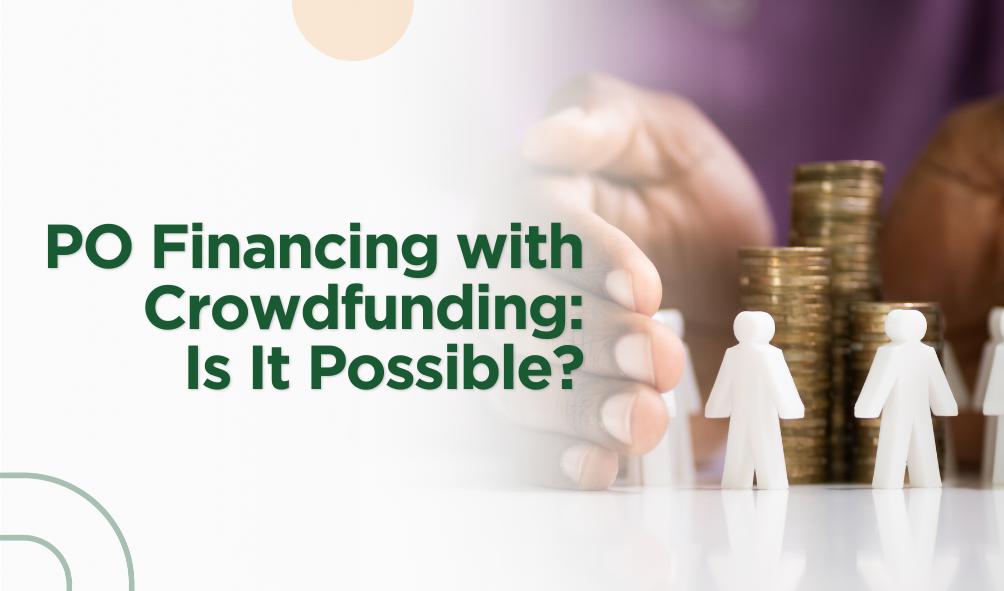PO Financing with Crowdfunding: Is It Possible?
PO Financing (Purchase Order Financing) is an increasingly popular financial solution among companies that want to fulfil customer orders without having to sacrifice their own working capital. Traditionally, PO financing is provided by banks or other financial institutions. However, with the development of technology and the emergence of alternative business models, crowdfunding is starting to be considered as one of the innovative options for PO financing. But, can crowdfunding-based PO financing really be applied? This article will explore its potential, challenges, and real-world implementation examples.
Also read:Import Financing by Securities Crowdfunding
What is PO Financing?
Before discussing crowdfunding-based PO financing further, it is important to understand what PO financing is. PO financing is a form of financing where a company obtains a loan to fulfil customer orders before payment from the customer is received. These loans are usually used to purchase raw materials, pay suppliers, or fulfil other production costs needed to complete the order.
This model is particularly useful for small and medium-sized companies that often lack working capital but have large orders from solid customers. Unfortunately, access to PO financing from traditional financial institutions is often hindered by strict requirements, such as asset collateral or good credit history. This makes many companies unable to utilise PO financing offered by banks or conventional financial institutions.
Read also:Export Financing with Securities Crowdfunding
Crowdfunding: An Innovative Alternative
Crowdfunding is a method of raising funds where a project or venture is funded by a large number of people, usually through an online platform. It has been successfully used in various types of projects, from new product launches to social and charity funding. Crowdfunding allows companies or individuals to pitch their ideas or projects directly to a wide audience, who can then choose to provide funds according to their interests.
However, the use of crowdfunding for PO financing is still relatively new and not widely practised. Existing crowdfunding platforms, such as Kickstarter or Indiegogo, focus more on reward or equity-based funding. However, there is a great opportunity to adapt this model for PO financing, especially through what is known as ‘crowdlending’ or peer-to-peer (P2P) lending.
Also read:Islamic Crowdfunding-Based Agrarian Financing: Concept, Akad, and Benefits
How Does Crowdfunding-Based PO Financing Work?
In the crowdfunding-based PO financing model, companies that need funds to fulfil orders can submit proposals on crowdfunding platforms. This proposal should include key information such as the amount of funds required, order details, and projected returns to investors. Investors, who can be individuals or institutions, will review the proposal and provide funds if they believe the project will be successful and provide a decent return.
Once the order is fulfilled and payment from the customer is received, the funds are then used to repay the investor along with a margin or other agreed-upon returns. Thus, the company can fulfil orders without having to wait for capital from customers, while investors benefit from the interest on their loans.
Benefit Potential
- Easier Access to Capital: Crowdfunding-based PO financing can provide easier access to capital for small and medium-sized enterprises that may not qualify for traditional financing from banks or large financial institutions.
- Diversification of Funding Sources: Companies can diversify their funding sources and not just rely on one financial institution or bank. This provides greater flexibility in capital management.
- Lower Credit Risk: In many cases, credit risk can be shared between multiple investors, which in turn can make funding easier to obtain and more affordable for companies.
- Increased Transparency and Trust: Crowdfunding platforms often demand higher transparency, both on the part of the company seeking funds and on the part of investors. This can increase trust between both parties
Challenges Faced
- Unclear Regulations: In many countries, including Indonesia, regulations for crowdfunding are still in the developmental stage. This creates uncertainty for both companies and investors, especially with regards to legal aspects and the safety of invested funds.
- Risks for Investors: Investors may face higher risks compared to traditional investments as the project is dependent on the success of certain orders. If the order fails to fulfil or problems occur in the process, investors may lose some or all of their capital.
- Lack of Financial Literacy: Many small businesses may not have a good understanding of how crowdfunding works. Further education is needed to ensure that they can utilise this model effectively and profitably.
- Cost and Time of Fundraising: The process of raising funds through crowdfunding can take a considerable amount of time and the associated costs for promotion or marketing can also be significant. This can be prohibitive for companies that need quick funds.
Implementation Examples and Case Studies
A number of overseas crowdlending platforms have started to provide PO financing services. For example, Kriya in the UK allows companies to fund their invoices and orders through funds raised from institutional and individual investors. Through this platform, companies can access funds quickly and flexibly without having to go through a lengthy approval process as is common in traditional banks.
In Indonesia itself, the application of crowdfunding-based PO financing is still very limited. Most crowdfunding platforms in Indonesia still focus on consumer loans or equity-based funding. However, with the increasing financing needs in the MSME sector and the rapid development of financial technology (fintech), the potential to develop crowdfunding-based PO financing in Indonesia is huge. Some local platforms such as Nabitu have started to expand their services towards crowdlending for businesses, although the main focus is still on invoice financing.
Read also:How Islamic Securities Crowdfunding (SCF) Contributes to Environmental, Social, and Governance (ESG)
Conclusion
Crowdfunding-based PO financing is an innovation that has great potential, especially for small and medium-sized companies looking for alternative financing. This model can provide easier access to capital, diversification of funding sources, and credit risk sharing. Nonetheless, this model still faces various challenges, ranging from immature regulations to the risks faced by investors. However, with the development of technology and increased financial literacy, this model could become one of the important financing solutions in the future.

Reference
- PO Financing dan Invoice Financing, Solusi Investasi dan Tambah Modal Usaha! – Danamart. (2024). Danamart.id. https://danamart.id/blog/2024/06/po-financing-dan-invoice-financing-solusi-investasi-dan-tambah-modal-usaha/
- Niko Ramadhani. (2019, January 31). Untungnya Mengajukan Pinjaman Dengan PO Financing! Akseleran Blog; Akseleran. https://www.akseleran.co.id/blog/po-financing/
- finblog. (2019). Perbedaan P2P Lending dan Crowdfunding – Fintag. Fintag.id. https://blog.fintag.id/perbedaan-p2p-lending-dan-crowdfunding/
- Anil Stocker: Kriya is the new name for MarketFinance | We are a fintech platform that keeps business flowing brilliantly. (2022). Kriya.co. https://www.kriya.co/blog/marketfinance-is-now-kriya-a-note-from-our-co-founder-and-ceo
- Purchase Order Financing: What It Is and How to Get It. (2023, October 6). NerdWallet. https://www.nerdwallet.com/article/small-business/purchase-order-financing
- Smith, T. (2023, October 6). Crowdfunding: What It Is, How It Works, Popular Websites. Investopedia. https://www.investopedia.com/terms/c/crowdfunding.asp







